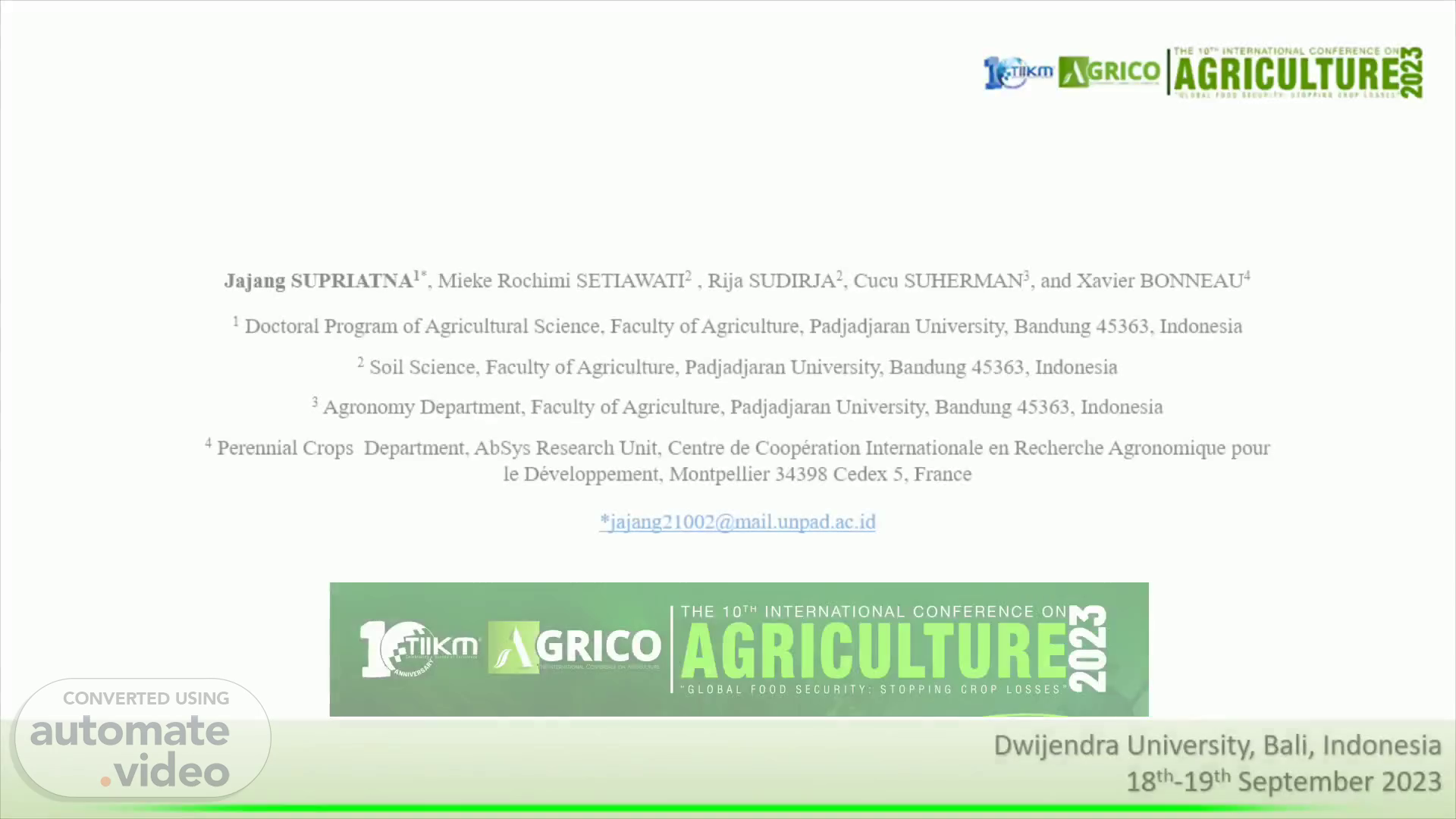
CHEMICAL AND BIOLOGICAL TRAITS OF CO-COMPOSTED PALM OIL MILL WASTE FOR BIO-ORGANIC FERTILIZER
Scene 1 (0s)
[Audio] Good morning everyone, ladies and gentlemen I would like to present my research, this is part of my dissertation on chemical and biological traits of co-composted palm oil mill waste for bio-organic fertilizer to support global food security. I am Jajang Supriatna, with my co-authors, Professor Mieke Rochimi Setiawati, Dr. Rija Sudirja, Dr. Cucu Suherman, and Xavier Bonneau PhD. First, I'll go through the Introduction, The objectives of research, Methods and trial design, Result and discussion, and finally I'll outline the conclusion..
Scene 2 (39s)
[Audio] We know that Indonesia has been a key country for producing CPO with about 62%, this imply to high processing of oil palm fruit fresh bunches to generate high waste, such as liquid waste, POME and solid waste, EFB. The other parts according to Stichnothe and Schuchardt, 2010, and our experience during the last 15 years, working in palm oil plantation, this power plant station, which processed the fiber, shells, to get a power for mill electricity, will be generated ash, we called boiler ash, rarely to be used, we propose the idea to close all the waste into composting plant through co-composting process and convert it to become bioorganic fertilizer.
Scene 3 (1m 21s)
[Audio] In the first study, we used modeling tools to estimate the potential outcome of these wastes, resulting in about 191 kg C, which can be returned to the soil and 38 kg N, from 1 ton of these raw materials with 21% EFB, 60% POME and the rest was Ash..
Scene 4 (1m 41s)
[Audio] These waste have a potential content of nutrients that are needed from soil fertility improvement, and nutritional plant growth, such as N, P, K, and Mg. The challenge is how to degrade lignin on the solid waste of EFB, and maximize nutrients recovery. The other points that I would like to highlight is the heavy metal content that will be an issue. Let us analyze further on the result in the next slide..
Scene 5 (3m 3s)
[Audio] This research aims to convert all palm oil mill waste to organic fertilizers through the co-composting process that meets the standard regulation of Indonesian Organic Fertilizer Regulation, by the Minister of Agriculture Decree no. 261/2019, SNI-2004, and the international standard..
Scene 6 (3m 28s)
[Audio] The research was carried out in the Belitung island, part of the Indonesian province, Bangka-Belitung Province, the position is between Kalimantan/Borneo Island, and Sumatera Island, and is actually quite popular as a second of Bali. The average rainfall here is 2500-3000 mm per year, air temperature 27-35 0C, 100 m above sea level, mostly podzols soil, and the composting system we used in the trial was open circulation with a roof system..
Scene 7 (4m 1s)
[Audio] Following Baron et al. (2019), all raw materials were combined in pile system (pyramidal shape), generally there would be several activities here, microbial, CO2 emission, gases emission, heat, and leachate, eventually, until 60 days processed, will get stabilized product as compost, which we called bioorganic fertilizer, due to the rich of organic compound and rich of beneficial microbes. We analyze with the guidance of Indonesian regulation and international standards..
Scene 8 (4m 35s)
[Audio] By randomized block design, we combined raw material of waste, with and without boiler ash, with and without additional microbes with increasing doses. Three replications, 8 combination treatments, 1 pile was 1 ton volume, 2: 1 POME rasio of spraying every day until 45 days, and turning interval every 10 days until 40 days..
Scene 9 (5m 12s)
[Audio] This was the condition of the piling system of the composting trial. Day 1 and Day 60 (product)..
Scene 10 (5m 22s)
[Audio] Let us move on to the result. As I highlighted earlier about the heavy metal content, we concluded that all heavy metal content in the raw material was below the standard. Therefore, the product is safe for the environment and trees.
Scene 11 (5m 57s)
[Audio] You can see here that there were several conditions during the composting process. The first 2 days, the piling was still in the mesophilic stage, then follow by the thermophilic phase, we see an increase in the temperature pick, up to 62 degrees, after 10 days we turned and slowly decreased the temperature, up to 35 degrees, in the cooling phase, and 30 degrees during the maturation process. crossing correlation with pH, the compost product gradually increased in pH, making it alkaline (pH 9)..
Scene 12 (7m 24s)
[Audio] It is interesting here that from the mass budget of 1 ton raw material, during the 60 day composting process, 16 –19 % of weight (wet bases) reduced. Once we add boiler ash and more additional microbes, systematically decrease of microbial activity compared to without addition microbes and low dosage of additional microbes, high population of microbial activity here in A1D0 and A1D1 treatment..